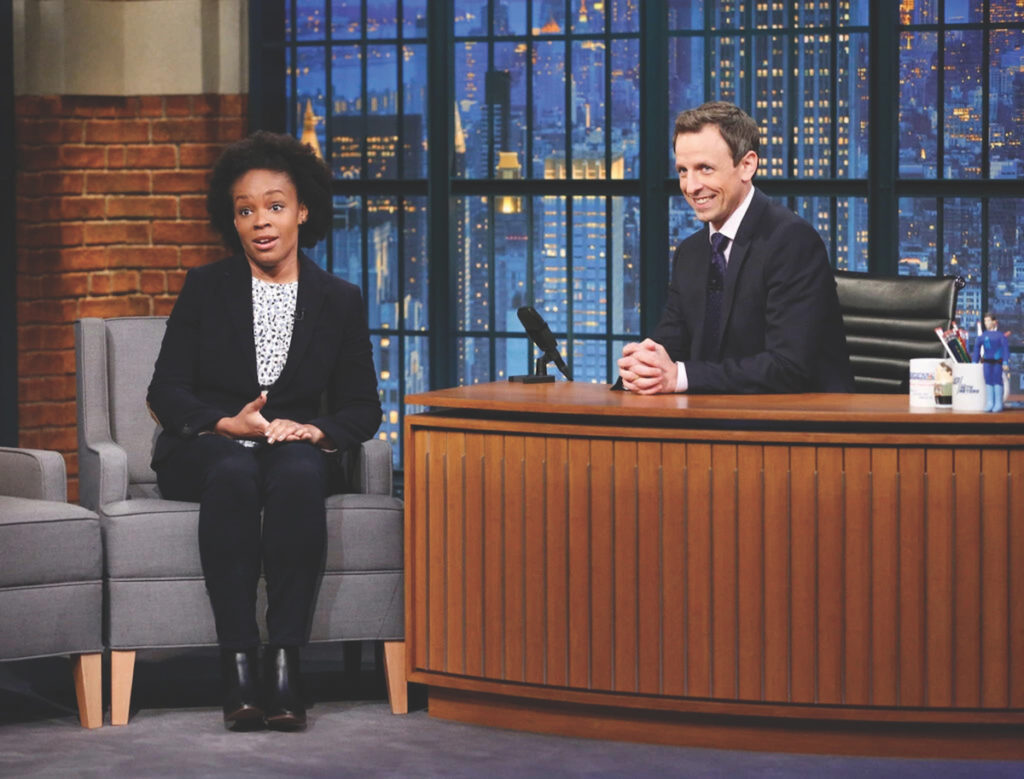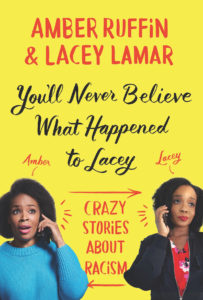
Under no circumstances should you crack the covers of Amber Ruffin’s and Lacey Lamar’s You’ll Never Believe What Happened to Lacey in a place you need to be quiet — say, in bed, next to your partner, who is trying to fall asleep. The stories in it will frequently make you explode with laughter. And then they will make you groan loudly and want to stick a fork in your eye.
Ruffin and Lamar are sisters. They are Black. They grew up in Omaha, Neb., near where their parents were stationed in the U.S. Air Force. At the end of their deployment, the elder Ruffins decided to stay in Omaha and raise a family, which came to include five children, including Ruffin and Lamar.

The sisters’ lives diverged when Ruffin left Omaha to pursue a career in comedy. She now lives in New York. She has written for Late Night With Seth Meyers since 2014. At that time, she was the first Black woman in the U.S. hired to write for a late-night network television talk show. All the while, Lamar remained in Omaha.
Omaha, the sisters write, is the 44th largest city in America, ahead of New Orleans, Oakland, Cleveland, Pittsburgh, Salt Lake City, Orlando, and Minneapolis. It is, therefore, not “some backwoods town.” And yet, it is the site of inexcusably racist behaviors, which the two have documented over the years in text exchanges, emails, and phone calls. They relate these episodes with an appreciation of what may seem absurd to most whites, hence the “you’ll never believe” part of the book’s title. Blacks in America, they write, will identify with such stories all too quickly.
Lamar, Ruffin writes, “is small and nice and cute.” Her appearance seems to serve as a magnet, drawing out a wealth (or poverty?) of racist behaviors and comments over the years. The settings are as varied as church revivals, department stores, and doughnut shops. Innumerable stories take place in Lamar’s various places of work. They relate narratives about refusal of service, “confused” identity (prostitutes, baby dolls, celebrities, heroes of Black history), and police brutality.
The sisters employ plenty of visual aids to make their points. From the outset, they each use a different type font to distinguish between their narratives and comments: Helvetica for Ruffin, Bembo for Lamar. In the tradition of sibling rivalry, it is fair to say that, in terms of sheer word count, Ruffin dominates. But when she interjects, Lamar never fails to bring clarity and humor. Her words count, too. Explaining her motivation for aggregating and publishing her stories, Lamar writes that she’s not intending “to go ‘full hippie’ on you, but leaving these things unsaid gives them power.”
In addition to making it easy for readers to tell the sisters apart, the book’s many other graphics help the sisters deliver punchlines. For instance, on the first page of the book, Ruffin relates a tale in which Lamar paid a white store cashier with a personal check incorporating an image of a famous Black activist. The cashier exclaimed, “Wow! You have checks with your picture on ’em?” Readers would not appreciate the absurdity and humor were they not able to see, just below the text, images of two checks — one with the rounded, iconic face of Harriet Tubman, the other with Lamar’s pixie-like mien. A different story, this one about white co-workers’ running comments about the similarity between Lamar’s face and the face of a black baby doll in a gift shop, similarly relies on visuals. The sisters finally realize that there is a familial resemblance between Lamar and the doll. They include a photo of the doll’s head and a photo of a much-loved niece (who is a very young child).
The sisters’ origin story in Omaha matters, but they don’t completely reveal its import until about midway through the book. Sandwiched between humorous stories of racism run amok is an account of their parents’ initial business venture in Omaha. The two started a child-care center in North Omaha, which, the sisters explain, has a large population of Blacks and is historically underserved. They bought a former elder-care center and converted it, turning it into a thriving business “where almost every Black family in Omaha had a kid there,” Ruffin writes.
Along came a white woman empowered to decide which facilities would be certified to receive government funding, upon which the center depended. Her racism set in motion a series of events that caused the business to fail. “I never tell white people that story,” Ruffin writes, “because they can’t frigging stand hearing it. Honestly, they look like they’re in pain as they’re listening to me tell it and are annoyed that they have to carry this information around with them. I have never been able to understand why white people have such a low tolerance for hearing about racism. I mean, we have to live it! The least you could do is nod your head.”
Because of Ruffin’s and Lamar’s comic sensibilities and skills as storytellers, readers will more than nod their heads. I can think of no better book at the moment to illustrate the stupidity and devastation of microaggressions. By definition, these are unintentional acts of racism, passively conveyed, mindless, with the potential to wound. Ruffin addresses such interactions head on:
“There are going to be a lot of times while you’re reading this book when you think, There is no motivation for this action. It seems like this story is missing a part because people just aren’t this nonsensically cruel. But where you see no motivation, you understand racism a little more. It’s this weird, unprovoked lashing-out, and it never makes any sense. It’s why it’s so easy for people to believe the police when they beat someone up — because no one would be that cruel just because the person was Black. But they are! So, as you read this book, when you see there’s no motivation, know that there is: racism.”
